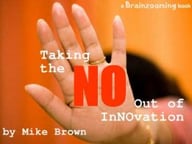Brainzooming blog reader, Randall Rozin, Global Director, brand management and marketing communications at Dow Corning is back with a guest post on lead management system success. Randall's exploration of the topic is a great reminder of the interconnected nature and vital need for follow-up throughout to achieve the results from the investment in a lead management system. Here's Randall:
 Lead Management System Success
Lead Management System Success
Generating a lead and following it to closure is a pretty simple concept. You define your target audience, develop a compelling offer, communicate the offer to your target, they respond, you follow up, and Voilà: a sale happens.
5 Key Phases from Exposure to Closure
As you can imagine, in the real world of business to business marketing it quickly becomes more complex. Whether you choose to develop your own process or outsource it to others, you’ll need to consider these five key phases for lead management system success.
1. Exposure
The "exposure" in this model can be thought of as the stimulus that you’re putting out into your market in search of a given type of response. In this phase, your marketing and sales teams have predetermined what an ideal lead looks like based on attributes, buying readiness, position, and timing. You’ve designed your offer to attract maximum customer response and fulfillment pieces are in place to properly respond to inquiries generated. Marketing campaign information is loaded into your CRM system to assist with funnel management reporting and downstream marketing ROI calculations. Internal teams and channel partners are pre-informed of exposure campaign objectives, available collateral and sales aids, and the timing of promotions. Your digital properties are also on the ready to help reposit materials and to serve as additional messaging outlets and lead source
2. Capture
Leveraging a common pre-qualification form to help screen for ideal leads based on upfront criteria makes the capture process more efficient. This allows the most valuable leads to proceed on to sales while less qualified leads are closed out immediately or returned to a nurture stream for future marketing actions. It is important to have a well thought out capture mechanism to catalog inquires coming from multiple marketing exposure campaign tactics. Being organized upfront is important for quick fulfillment of customer inquiries, and in being able to track marketing effectiveness and ROI.
3. Make Sure
To ensure your lead is sales ready, based on your qualification criteria, scoring systems are helpful to quickly communicate the sales readiness of a given lead before passing it on to sales or returning it to the nurture stream. Automating your scoring system in your CRM tool is valuable as it allows you to process more leads at a much faster pace. A fully qualified lead should be converted to an active opportunity.
4. Nurture
In many business-to-business firms, it is less common for marketing to generate an immediate sale. Team procurement processes, need for testing, specification writing and many other factors make for long sales cycles in business-to-business. With longer sales cycles comes the real need to keep in contact with a targeted customer to cultivate your relationship, to provide additional reasons why your solution is differentiated, to make additional offers, or simply to remind the customer that you are still interested in their business. Thinking proactively about your nurture streams and content requirements helps you avoid ‘dead air’ in between exposure and closure phases and enables your interim communications to be more strategic, integrated, and driven to a specific, desired outcome.
5. Closure
In this final phase you will either convert your opportunity into a sale or you won’t. Either way you need to connect the dots in your CRM system, ensure feedback to marketing is in place to measure ROI and inform future campaign strategies. If the closure phase results in a ‘no sale’ capture the reasons why. If the closure phase results in a sale, well done! But your work is not complete as you still have the opening to include your customer in future nurture streams designed to cross-sell and up-sell additional offers.
Bottlenecks in lead and opportunity management processes involve not having the proper key performance indicators in place with clear roles and responsibilities for your sales and marketing organizations – including channel. Additionally, having multiple repositories for customer and campaign data is nearly as dilutive to your enterprise efforts as having no repository at all as it limits your real pipeline view and forces many manual processes to aggregate information for management review and investment decision making. A central CRM system (customer relationship management) is paramount to orchestrating your overall process and in delivering the visibility of your overall sales funnel and helping you connect marketing ROI back to specific lead generation activities.
With KPIs (key performance indicators) and CRM systems in hand, you’ll be on your way to having a more accurate sales funnel with increased sales effectiveness and higher quality sales leads. As a result, your sales force will be more motivated with the leads they receive and your marketing teams will have improved insight on marketing effectiveness and improved creative direction for ongoing marketing nurturing programs. – Randall Rozin
If you enjoyed this article, subscribe to the free Brainzooming blog email updates.
Download the free ebook, “Taking the NO Out of InNOvation” to help you generate fantastic creative thinking and ideas! For an organizational innovation success boost, contact The Brainzooming Group to help your team be more successful by rapidly expanding strategic options and creating innovative plans to efficiently implement. Email us at info@brainzooming.com or call us at 816-509-5320 to learn how we can deliver these benefits for you.




